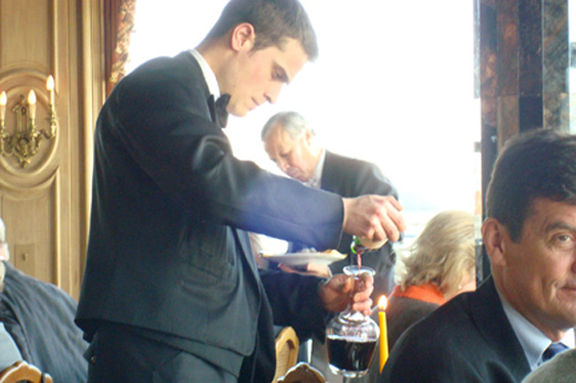
Tasting Wine Prior to Serving Guests (and a great wine education resource)
A really interesting thread on the Guild of Sommeliers forum caught my eye via Twitter this week.
It was entitled "Tasting Wine Prior to Serving Guests."
"Whether it be for high-end bottles or just all around standard practice," asked one member, "how many of you actually taste individual bottles prior to serving your guests? Have you had any negative feedback from guests after you've informed them you've checked their wine for flaws?"
A heated debated ensued.
One of the most interesting posts was by Matt Stamp, the Guild's education director.

Making reference and synopsizing some of the previous posts, he wrote:
"From my own experience in selling wine at a restaurant in which we did not taste the wines (V. Mertz, Omaha, NE) vs. one in which we did (The Farmhouse Inn, Forestville, CA), I can tell you that our bin of flawed/rejected bottles at the former was nearly empty, and at latter was always full! Wines may not be poisoned, but they sure are corked/oxidized/heat-damaged all the time…"
"Many guests may actually feel relieved that they do not have to check the bottle and make a pronouncement themselves, particularly if they are a bit nervous."
"From another perspective, sommeliers are expected by guests — particularly savvy guests —to have a good handle on how a wine is drinking right now, or to understand one vintage vs. another from the same producer, and the fact of the matter is that tasting every bottle that you open can be an important and valuable part of a sommelier's education, and understanding of their own program. Obviously, we should all be tasting as many wines as possible before buying, but sometimes that is just not an option."
There were a wide range of views and a few commenters noted that it's indecorous to spit wine while working in the dining room. How could one taste so much wine over the course of an evening without spitting?
The bottom line is that there is a wide range of approaches to this thorny issue and a lot rides on the context and situation. It's one thing if you're pouring a 1961 Bordeaux with a crumbly cork, another if you're pouring young, fresh Txakoli from the Basque Country with a screw cap seal.
One interesting thing that emerged from the discussions is that diners across the U.S. are becoming more accustomed to their sommeliers tasting the wine before serving or at least pouring a small taste that they can smell before serving it (a number of commenters wrote the latter approach is the best route).
It's a really interesting thread that reveals a lot about wine connoisseurship and wine service in our country today.
If you're a member of the Guild, I highly recommend you check it out here.
If you're not a member, I highly recommend that you buy a subscription.
Honestly, I didn't realize that laypeople — like me — could sign up. I was under the impression that you had to be a candidate in the Guild's wine education program.
When I Facebook messaged Master Sommelier and Guild of Sommeliers Director of Operations Geoff Kruth asking him if he'd give me access to the thread (I was that intrigued by the Tweet about it), he gently reminded me that anyone can buy a membership.
I signed up right away, of course, and I discovered that the so-called "compendium" within the Guild's site is a superb wine education resource, with maps and appellation and producer profiles.
I'm so glad I made the investment and if you're so inclined, I encourage you to do so as well.
Jeremy Parzen
follow Jeremy @DoBianchi